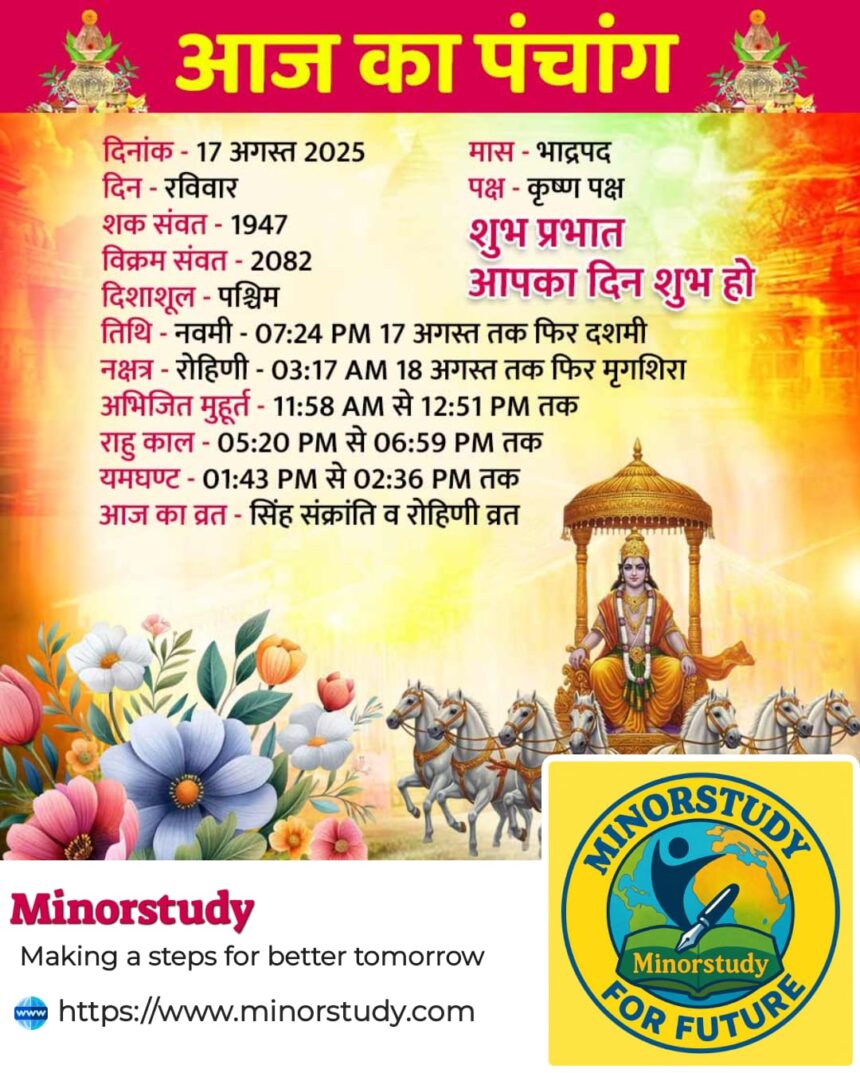7 Powerful Insights About Singh Sankranti & Rohini Vrat That Will Brighten Your Day
The Panchang of 17 August 2025 brings special significance with Singh Sankranti and Rohini Vrat. These observances are deeply rooted in Sanatan Dharma, connecting human life with celestial movements, spiritual growth, and cultural traditions.
- Today’s Panchang Overview
- History and Background
- Timeline of Singh Sankranti & Rohini Vrat
- 7 Key Significance Points
- 1. Spiritual Alignment
- 2. Health and Vitality
- 3. Prosperity and Growth
- 4. Auspicious Timings
- 5. Fasting and Devotion
- 6. Cultural and Community Impact
- 7. Ethical and Life Lessons
- FAQs About Singh Sankranti & Rohini Vrat
- Daily Life Impacts
- Wishing Traditions
- Important Points to Remember
- Conclusion: Importance of Singh Sankranti & Rohini Vrat
Understanding today’s Panchang helps us align with cosmic rhythms, make the most of auspicious timings, and integrate ancient wisdom into daily life.
Today’s Panchang Overview
दिनांक (Date): 17 August 2025
दिन (Day): रविवार (Sunday)
शक संवत: 1947
विक्रम संवत: 2082
दिशाशूल (Direction Inauspicious): पश्चिम (West)
मास (Month): भाद्रपद
पक्ष (Paksha): कृष्ण पक्ष
तिथि (Tithi): नवमी till 07:24 PM, then दशमी
नक्षत्र (Nakshatra): रोहिणी till 03:17 AM 18 August, then मृगशिरा
अभिजित मुहूर्त: 11:58 AM – 12:51 PM
राहु काल: 05:20 PM – 06:59 PM
यमघण्ट: 01:43 PM – 02:36 PM
आज का व्रत: सिंह संक्रांति व रोहिणी व्रत
History and Background
Singh Sankranti
Singh Sankranti, also called Leo Sankranti or Simha Sankranti, marks the Sun’s transition from Cancer (Karka Rashi) to Leo (Simha Rashi). This movement is considered highly auspicious in Hindu astrology, symbolizing strength, leadership, courage, and vitality. Historically, this day has been observed with:
Sun worship (Surya Dev puja)
Fasting for physical and spiritual benefits
Rituals for health, prosperity, and wisdom
The practice traces back to Vedic times, where sages emphasized aligning human activities with solar transitions to enhance life energy and spiritual growth.
Rohini Vrat
Rohini Vrat is observed on the day when the Moon is in the Rohini Nakshatra, one of the 27 lunar constellations. Rohini is associated with prosperity, growth, and fertility. Ancient texts recommend fasting, prayers, and charitable acts on this day to invite abundance and harmony into personal and social life.
Timeline of Singh Sankranti & Rohini Vrat
Vedic Era: Observances linked to agriculture, solar worship, and cosmic alignment.
Medieval Period: Temples documented rituals, fasting practices, and spiritual discourses for Singh Sankranti and Rohini Vrat.
Modern Era: Integrated into daily Panchang, astrology guidance, and public awareness, emphasizing health, spiritual benefits, and ethical living.
7 Key Significance Points
1. Spiritual Alignment
Observing Singh Sankranti and Rohini Vrat helps align personal energy with cosmic rhythms, enhancing meditation, inner strength, and spiritual clarity.
2. Health and Vitality
Early morning rituals like sun salutations, holy baths, and mindful diets promote digestion, immunity, and overall well-being.
3. Prosperity and Growth
Rohini Nakshatra is closely associated with material and spiritual growth, encouraging devotees to focus on wealth creation, education, and personal development.
4. Auspicious Timings
The Panchang indicates Abhijit Muhurat (11:58 AM – 12:51 PM) for performing important rituals, Rahu Kaal and Yamghant for avoiding inauspicious actions, guiding devotees for optimal timing.
5. Fasting and Devotion
Fasting on Singh Sankranti and Rohini Vrat strengthens discipline, self-control, and mindfulness, helping individuals detoxify physically and spiritually.
6. Cultural and Community Impact
These observances encourage community prayers, temple visits, and charitable activities, fostering social cohesion and shared spiritual practice.
7. Ethical and Life Lessons
Focusing on discipline, gratitude, and service to others during these observances teaches life lessons of patience, empathy, and alignment with cosmic and societal order.
FAQs About Singh Sankranti & Rohini Vrat
Q1: What is Singh Sankranti?
A: It is the day when the Sun enters Leo (Simha Rashi), considered auspicious for health, courage, and spiritual strength.
Q2: What is Rohini Vrat?
A: Rohini Vrat is observed when the Moon is in Rohini Nakshatra, promoting prosperity, growth, and spiritual alignment.
Q3: What rituals should be followed?
A: Devotees perform sun worship, prayers, fasting, charity, and meditation. Temple visits and feeding the needy are encouraged.
Q4: Can fasting be partial?
A: Yes, devotees may observe fruit or milk fasts if full fasting is not possible.
Q5: Who can observe this Vrat?
A: Anyone seeking health, spiritual growth, prosperity, and cosmic alignment can observe it.
Q6: Why is Abhijit Muhurat important?
A: It is considered a highly auspicious period for starting new ventures, rituals, or meditation practices.
Daily Life Impacts
Health Benefits: Fasting and morning sun rituals enhance digestion, immunity, and energy.
Spiritual Awareness: Meditation and prayers help reduce stress and increase mindfulness.
Societal Harmony: Community activities promote empathy, social cohesion, and shared cultural identity.
Life Planning: Guidance from Panchang helps in timely decision-making and ethical actions.
Cultural Continuity: Observing traditional rituals preserves heritage and spiritual knowledge for future generations.
Wishing Traditions
On Singh Sankranti and Rohini Vrat, people greet each other with blessings like:
“सिंह संक्रांति और रोहिणी व्रत की शुभकामनाएँ। आप हमेशा स्वस्थ, समृद्ध और प्रसन्न रहें।”
“May the Sun and Moon bless you with vitality, prosperity, and spiritual growth today and always.”
These wishes reinforce community bonding, positivity, and mutual respect.
Important Points to Remember
Check the exact Panchang timings before rituals.
Observe fasting mindfully, maintaining hydration and health.
Focus on charity, community service, and ethical actions.
Combine traditional observances with modern mindfulness practices.
Learn lessons from celestial events to enhance personal, social, and spiritual life.
Conclusion: Importance of Singh Sankranti & Rohini Vrat
Singh Sankranti and Rohini Vrat are more than mere astronomical or religious events. They integrate cosmic awareness, spiritual discipline, health practices, and societal harmony. Observing them encourages:
Physical well-being through fasting and rituals.
Mental clarity and spiritual growth through prayers and meditation.
Social cohesion through community activities and charitable work.
Cultural preservation through traditional rituals and Panchang guidance.
By understanding the history, significance, and daily life applications, these observances remind us that alignment with cosmic rhythms, ethical living, and mindfulness can create a balanced, prosperous, and spiritually enriched life.








